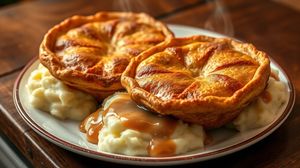
The Greenwich Foot Tunnel is a fascinating piece of engineering that allows pedestrians to cross beneath the River Thames, linking the London boroughs of Greenwich and Tower Hamlets. Opened in 1902, the tunnel was designed to provide a convenient route for workers living south of the river to reach the docks on the Isle of Dogs. This historic passage continues to serve thousands of commuters and visitors each year and remains one of the unique foot routes under London's iconic river.
The tunnel stretches approximately 370 meters and runs at a depth of between 13 and 15 meters below the riverbed. Its design showcases the ingenuity of early 20th-century civil engineering with an iron and concrete structure that has stood the test of time. The tunnel is lined with classic white glazed tiles, typical of the Edwardian era, which add to its vintage charm.
One of the more unusual aspects of the Greenwich Foot Tunnel is its distinctive entrance buildings. The tunnel is accessed through two cylindrical shafts topped with glass domes at either end. These provide a dramatic first impression and are iconic landmarks in themselves due to their unique design and historical significance.
During World War II, the tunnel was used as an air-raid shelter, providing refuge for local residents during the bombings. Despite the challenges of the time, it remained largely unscathed and was one of the few river crossings that didn't suffer significant damage, highlighting its robust construction.
Interestingly, the tunnel is not only a convenient way to cross the Thames but also a designated part of the National Cycle Route 1. Cyclists, however, are required to dismount and walk their bicycles through the tunnel, ensuring the safety of all users in the somewhat narrow and busy corridor.
In recent years, the tunnel has undergone extensive refurbishment to preserve its history and enhance its usability. This includes upgraded lifts and improved lighting, ensuring that the tunnel remains an accessible and pleasant experience for modern pedestrians while retaining its historical essence.

Making the Most of Your Visit:
The Greenwich Foot Tunnel might be over a century old, but it still doesn't take contactless payments! Just kidding, it's free to use. So don't worry about having gone cashless—there's no ticket booth to stop you from exploring this impressive tunnel.
Look out for the domed entrances—they're easy to miss if you're not looking up! These beautiful structures are not only iconic but also house the lifts and spiral staircases that take you down into the tunnel. The glass domes make for a great photo opportunity, especially at sunset when they reflect the golden light.
For those with a sense of history, consider that you're pacing along the same roots as workers from more than a hundred years ago. Pause and think about how this engineering marvel, once a vital passage for dock workers, survives today as a pedestrian link between two bustling areas of London.
If you're visiting during peak times, be prepared for it to be quite busy. It can be a popular route for both locals and tourists, so plan for a little extra time if you're in a rush. And remember, cyclists must dismount, so there's no need to rush even if you've got a bike in tow.
Once you've walked through the tunnel and find yourself in sunny Greenwich (or rainy—it's still London after all!), enjoy exploring historic Greenwich. Checking out the nearby Cutty Sark or the Royal Observatory might be the perfect way to end your unique Thames-crossing adventure.

Visiting Times & Costs:
The Greenwich Foot Tunnel is open to the public 24 hours a day, seven days a week, making it an accessible and convenient option for crossing the River Thames at any time.
There is no cost associated with using the tunnel; it is free for pedestrians and cyclists, though cyclists are required to dismount and walk their bikes through the tunnel.
Accessibility within the Greenwich Foot Tunnel is generally good, as it features lifts at both ends in addition to spiral staircases. These lifts are crucial for those with mobility impairments or those using strollers, although occasional maintenance may affect availability.

Address & Map:

Nearby:























